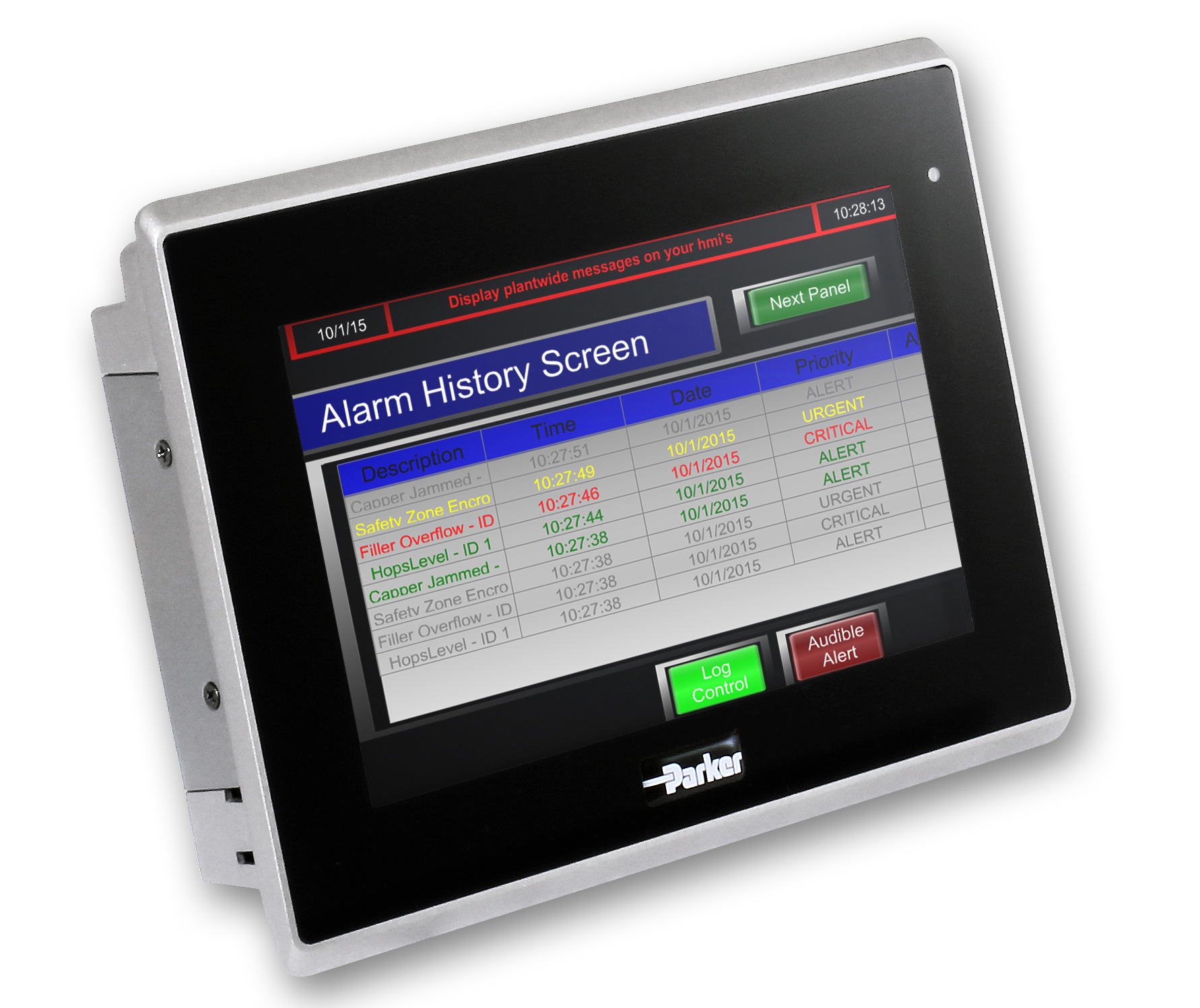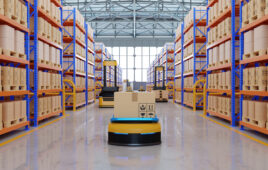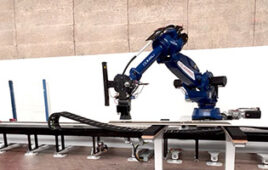Parker’s Electromechanical and Drives Division – North America now offers the PAC Terminal (PT) thin-client HMI.
The PT is a thin-client HMI developed to work seamlessly with the Parker Automation Controller (PAC). With the PAC handling the control and HMI logic, the PT is responsible for displaying the embedded HMI as well as sending touch screen input from the user back to the PAC. As a thin client, the PT significantly reduces the overall system costs when compared to a traditional HMI—especially when connecting multiple PTs to a single PAC.
The PAC is Parker’s all-in-one machine controls solution that combines PLC, HMI, and motion control functionality into a single device. Likewise, the PAC is programmed using a single integrated development environment (IDE) called Parker Automation Manager (PAM).
Parker has chosen to standardize on the IEC 61131-3 programming language and PLCOpen motion control function blocks. This choice provides machine builders the ability to use traditional ladder diagram (LD) but also to take advantage of the latest control languages available such as Structured Text (ST), Continuous Function Chart (CFC), and Sequential Function Chart (SFC). IEC 61131-3 brings object oriented-like programming capabilities to the automation industry with the ability to create custom function blocks, libraries, and various data types. This empowers OEMs to create modular code that can be re-used, which significantly reduces the overall time to develop machines.
“The same IEC 61131-3 programmed to control the PAC PLC logic is also used to control the logic of the embedded HMI, WebVisu,” explains Marissa Tucker, Product Marketing Manager of Controls and HMIs for Parker. “There is no tag sharing or additional layers of logic required to get the PLC to communicate to the HMI—they’re completely seamlessly integrated.”
Like traditional HMIs, WebVisu allows programmers to develop their HMI using easy drag-and-drop tools such as buttons, sliders, and premade alarm and recipe objects. However, WebVisu takes it to the next level, allowing developers to create libraries of visualization objects (or use some of Parker’s pre-made objects) to significantly reduce the time required to build common HMI functionality. Users can also use either pre-made themes or create their own to provide a visual motif throughout a project or multiple projects.
 WebVisu takes advantage of web publishing technology. This is what makes it possible to have multiple PTs attached to a single PAC controller. In addition, any remote client such as a browser or mobile device using Parker’s Remote Manager (RemoteMgr) app can connect to the embedded HMI simply by entering in the PAC’s IP address and target application. User management tools inside PAM allow developers to create various user groups with different read/write access on different screens or to specific objects. This ensures that the right information can be projected to the right users.
WebVisu takes advantage of web publishing technology. This is what makes it possible to have multiple PTs attached to a single PAC controller. In addition, any remote client such as a browser or mobile device using Parker’s Remote Manager (RemoteMgr) app can connect to the embedded HMI simply by entering in the PAC’s IP address and target application. User management tools inside PAM allow developers to create various user groups with different read/write access on different screens or to specific objects. This ensures that the right information can be projected to the right users.
Control engineers have two options when developing their HMI in PAM: either using WebVisu, a European-style visualization platform that is designed to easily integrate with the IEC 61131-3 programming language, or Parker’s incredibly popular and easy-to-use HMI, embedded Xpress. Both WebVisu and embedded Xpress provide remote capabilities by taking advantage of web publishing technology. Any remote client such as a browser or mobile device using the RemoteMgr app can connect to the embedded HMI simply by entering in the PAC’s IP address and target application. This means that an unlimited number of devices can connect to the PAC.
Beyond the HMI, the PAC makes motion control easy. Not only does it support the PLCOpen environment, but it comes packed with tools such as the CAM table editor, CNC capabilities using .dxf to G-code converters, graphical motion path editing, and pre-made inverse kinematic function blocks for robotics such as delta and H-bots, SCARA, and gantry systems. Tightly coupled motion is made possible by leveraging the speed and distributed clock capability of EtherCAT.
In addition to modular code design, EtherCAT allows modular hardware design by allowing users to connect to a near-unlimited number of EtherCAT devices, including the PAC I/O local and remote I/O system, Parker P-series motors and drives, PSD servo drives, AC30 drives, and third-party EtherCAT devices. Although EtherCAT provides the backbone to the Parker control strategy, the PAC is capable of communicating via Ethernet/IP, Profinet, Profibus, Modbus TCP, and Ethernet TCP/IP to ensure that it can work in any control system architecture.
The PT provides a window into the PAC, allowing for a traditional HMI look and feel while leveraging modern remote technology and single-device programming. The ability to provide a single solution and programming environment for PLC logic, HMI local and remote visualization, as well as motion control makes the PAC an all-in-one machine controller capable of solving the most difficult applications with ease and reduced time to market.
Parker Hannifin is a Fortune 250 global leader in motion and control technologies. For 100 years the company has engineered the success of its customers in a wide range of diversified industrial and aerospace markets. Learn more at www.parker.com.
Filed Under: Displays • HMIs • operator interfaces • monitors, Robotics • robotic grippers • end effectors





Tell Us What You Think!